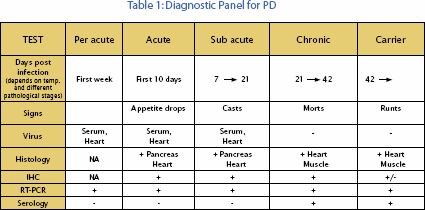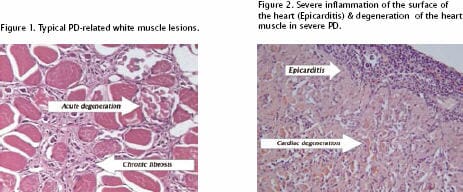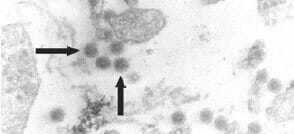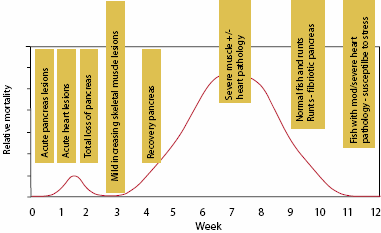
The diagnosis of PD is based on:
- Clinical signs
- Gross pathology
- Histopathology of pancreas, heart and skeletal muscle
- Serology and virology
- RT-PCR
The clinical signs and gross pathology of PD were described in Agenda no. 5 and a detailed description of the clinical and histopathological fi ndings can be found at www.blackwellsynergy.com/toc/jfd/25/1 {M.F. McLoughlin et al., 2002 Clinical and histopathological features of naturally occurring pancreas disease in farmed Atlantic salmon, Salmo salar L.} Recommendations on reducing the impact of PD disease outbreaks can be found in Agenda No. 8.
Histopathological examination still remains the principal method for confirming PD. The most important message regarding the interpretation of histopathological lesions is that there can be considerable variation in the appearance and severity of the lesions and that fish may be at different stages of the disease process at any particular sampling point, i.e., the pancreas may appear normal (recovered) but there are severe heart and skeletal muscle lesions, this does not mean that PD is not involved [Table1].

Salmon pancreas disease virus (SPDV) isolation is difficult from natural outbreaks, as the wild type virus is very slow growing in cell culture and can be easily overgrown by infectous pancreatic necrosis virus (IPNV) if IPNV is not neutralised. But recently a test has been
developed which can rapidly (<3 days) identify viraemic fish, i.e., those fish which have circulating virus, from the examination of fish sera. This rapid test developed at Stormont Veterinary Sciences Division in Belfast has the ability to detect both viraemic fish, and
fish that have been recently or more chronically infected, by the detection of specific PD antibody in the serum www.blackwell-synergy.com/toc/jfd/27/3.
Serological diagnosis can be used for retrospective confirmation of a PD outbreak with SPDV-neutralising antibodies appearing from 14-21 days post infection. Direct and real-time RT-PCR techniques have been developed and are available at a limited number of laboratories. These methods have the ability to detect very small amounts of the SPD virus RNA and may be useful in detecting very early infections and carrier fish. There are still technical difficulties to be overcome with immunohistochemical diagnosis and confirmation of PD, i.e., where SPD virus can be detected in the actual tissue lesion.
Differential diagnosis
It is important to distinguish PD from IPN in marine-farmed Atlantic salmon as pancreatic damage is common in both diseases and IPN virus has a tendency to overgrow SPD virus in cell culture, perhaps resulting in an under-diagnosis of PD. It is also important to remember that concurrent infection with IPNV and SPDV can occur.

In older fish, an important differential diagnostic consideration is Cardiomyopathy Syndrome (CMS), and, more recently, a condition known as heart and skeletal muscle inflammation (HSMI) has been described in marine salmon in Norway and Scotland. Severe PD-related cardiac lesions are very similar to those described in CMS and HSMI.
A panel of recommended diagnostic tests for SPDV and Salmonid alphaviruses (SAV) in general is presented in Table 1. If any advice is required regarding the application and interpretation of these tests is required, please contact the author at mfmcloughlin@ntlworld.com.

Figure 3: Norwegian Salmonid Alphavirus Photo: Are Nylund, University of Bergen

Figure 4: Sequential PD pathology at 12 - 14°C
September 2006

